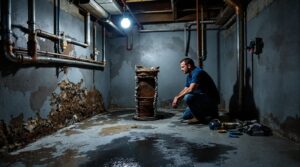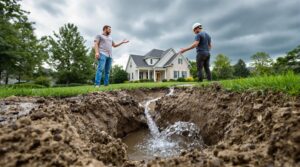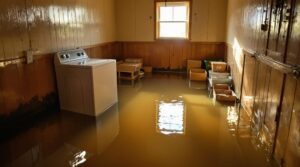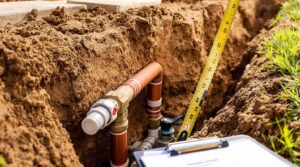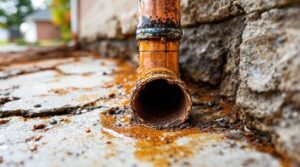Home insurance policies typically cover damages to drain pipes resulting from sudden, accidental events, such as unexpected breaks, ruptures, or backups. Coverage specifics vary by insurance provider, with standard policies often excluding maintenance-related issues like clogs from neglect of regular maintenance. Homeowners should confirm coverage for local risks, like sinkholes, and understand policy exclusions to guarantee adequate protection. Further exploration of home insurance policy details can provide a more thorough understanding of drain pipe coverage.
Key Takeaways
- Standard home insurance policies typically cover damages to drain pipes from sudden, accidental events, such as breaks or ruptures.
- Coverage specifics for drain pipe issues vary among insurance providers and policy types, including HO-1, HO-2, and HO-3 policies.
- Maintenance-related issues, such as clogs from neglect or pipe corrosion, are usually excluded from coverage.
- Homeowners should confirm coverage for local risks like sinkholes and landslides, which may affect drain pipes.
- Regular drain maintenance may be required to minimize claims and ensure coverage for drain pipe issues.
Overview of Home Insurance Policies
Homeowners often purchase insurance policies to protect their residences from unforeseen events. These policies provide financial security in case of losses or damages to their homes. Understanding home insurance basics is essential for individuals seeking protection for their property.
There are various policy types available, each catering to different needs and circumstances. A standard home insurance policy typically covers damages caused by perils such as fire, theft, and natural disasters. Some policies may also offer additional coverage for specific items, such as jewelry or artwork. Homeowners can opt for a replacement cost policy, which reimburses the full amount required to replace damaged items, or an actual cash value policy, which pays the depreciated value of the items. Familiarizing oneself with these policy types enables homeowners to make informed decisions when selecting a home insurance policy that suits their needs and provides adequate protection for their property. Most policies include Additional Living Expenses coverage to help pay for temporary housing if your home becomes uninhabitable due to a covered loss.
What Drain Pipe Issues Are Covered by Home Insurance
Typically, most standard home insurance policies provide coverage for damages resulting from sudden, accidental events affecting drain pipes, such as breaks, ruptures, or collapses. This may include issues like tree roots invading pipes, unexpected backups, or other unforeseen problems. The specific coverage and policy terms vary by insurance provider.
Policyholders may want to confirm their insurance covers typical risks in their geographic location, such as sinkholes, landslides, and other perils. Insurers often require homeowners to demonstrate they performed regular drain maintenance to help minimize the likelihood of insurance claims. Regular cleaning and checking for blockages can help prevent damage to pipes. Homeowners must understand their insurance policy and coverage before making a claim. Reviewing policy terms to identify potential insurance exclusions helps homeowners understand what may not be covered. If necessary, homeowners may consider additional coverage to include those exclusions. Similar to high-value items, certain types of drain damage may require separate endorsements for adequate coverage.
What Drain Pipe Issues Are Not Covered by Home Insurance
While standard home insurance policies provide coverage for sudden and accidental events affecting drain pipes, there are certain issues that are usually excluded from coverage. These may be maintenance-related or pertain to issues that could have been prevented or mitigated through proper care.
Some common drain pipe issues not covered by home insurance include:
- Clogs and blockages caused by neglect of regular drain maintenance
- Damage from root invasion if the homeowner failed to take preventative measures
- Pipe corrosion resulting from age or wear and tear
- Issues caused by poor installation of the drain pipes
- Damage from sewer backups if the homeowner neglected to install a backwater valve or other safety measures
All homeowners should be aware of the specific exclusions outlined in their home insurance policies. Proper drain maintenance is essential in preventing issues that may not be covered under standard insurance policies.
Factors Affecting Home Insurance Coverage for Drain Pipes
Because standard home insurance policies for drain pipes can vary depending on several key factors, it is essential to understand the specific provisions and exclusions outlined in each policy. Coverage limits for drain pipes, for example, can vary considerably among insurers and policy types, such as HO-1, HO-2, or HO-3 policies. These coverage limits often determine the extent of financial protection available for damages or losses resulting from issues such as burst, frozen, or collapsed drain pipes.
In addition, claim exclusions related to drain pipes may differ among insurers. Pre-existing conditions, poor maintenance, and neglect are common exclusions that may limit coverage for drain pipe claims. Understanding these factors can help policyholders identify potential gaps in their coverage. Evaluating these coverage specifics and comparing them across different policies can empower homeowners to make more informed decisions about their home insurance coverage for drain pipes. Working with a public adjuster can help homeowners better understand their policy coverage and maximize compensation for drain pipe damage claims.
Filing a Home Insurance Claim for Drain Pipe Issues
How do homeowners initiate the process of filing a home insurance claim for damages or losses resulting from drain pipe issues? The claim process typically begins with notifying the insurance provider of the damage or loss. Homeowners should review their policy to understand the specific requirements and procedures for filing a claim.
To facilitate the claim process, homeowners should:
- Document the damage or loss with photos and videos
- Gather receipts and records of any temporary repairs or mitigation measures
- Keep a record of all correspondence with the insurance provider
- Be prepared to provide access to the property for insurance adjustments
- Review and understand the insurance provider's settlement offer before accepting it
It is crucial for homeowners to carefully follow the claim process to guarantee a smooth and successful resolution of their claim. Insurance adjustments may be necessary to determine the extent of the damage and the amount of coverage available. For complex drain pipe claims, working with a public insurance adjuster can help maximize the settlement amount and ensure fair compensation.

